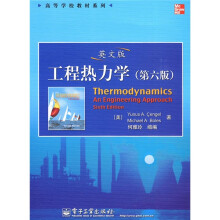高等学校教材系列:工程热力学(第6版)(英文版)

目 录内容简介
Chapter 1 INTRODUCTION AND BASIC CONCEPTS.
1-1 Thermodynamics and Energy
1-2 Systems and Control Volumes
1-3 Properties of a System
1-4 Density and Specific Gravity
1-5 State and Equilibrium
1-6 Processes and Cycles
1-7 Temperature and the Zeroth Law of Thermodynamics
1-8 Pressure
1-9 The Manometer
1-10 Problem-Solving Technique
Chapter 2 ENERGY,ENERGY TRANSFER,AND GENERAL ENERGY ANALYSIS
2-1 Introduction
2-2 Forms of Energy
2-3 Energy Transfer by Heat
2-4 Energy Transfer by Work
2-5 Mechanical Forms of Work
2-6 The First Law of Thermodynamics
2-7 Energy Conversion Efficiencies
2-8 Energy and Environment
Chapter 3 PROPERTIES OF PURE SUBSTANCES
3-1 Pure Substance
3-2 Phases of a Pure Substance
3-3 Phase-Change Processes of Pure Substances
3-4 Property Diagrams for Phase-Change Processes
3-5 Property Tables
3-6 The Ideal-Gas Equationof State
3-7 Compressibility Factor——A Measure of Deviation from Ideal-Gas Behavior
3-8 Other Equations of State
Chapter 4 ENERGY ANALYSIS OF CLOSED SYSTEMS
4-1 Moving Boundary Work
4-2 Energy Balance for Closed Systems
4-3 Specific Heats
4-4 Internal Energy,Enthalpy,and Specific Heats of Ideal Gases
4-5 Internal Energy, Enthalpy, and Specific Heats of Solids and Liquids
Chapter 5 MASS AND ENERGY ANALYSISOFCONTROL VOLUMES
5-1 Conservation of Mass
5-2 Flow Work and the Energy of a Flowing. Fluid
5-3 Energy, Analysis of Steady-Flow Systems
5-4 Some Steady-Flow Engineering Devices
5-5 Energy Analysis of Unsteady-Flow Processes
Chapter 6 THE SECOND LAW OF THERMODYNAMICS
6-1 Introduction to the Second Law
6-2 Thermal Energy Reservoirs
6-3 Heat Engines
6-4 Refrigerators and Heat Pumps
6-5 Perpetual-Motion Machines
6-6 Reversible and Irreversible Processes
6-7 The Carnot Cycle
6-8 The Carnot Principles
6-9 The Thermodynamic Temperature Scale
6-10 The Carnot Heat Engine
6-11 The Carnot Refrigerator and Heat Pump
Chapter 7 ENTROPY
7-1 Entropy
7-2 The Increase of Entropy Principle
7-3 Entropy Change of Pure Substances
7-4 Isentropic Processes
7-5 Property Diagrams Involving Entropy
7-6 What Is Entropy?
7-7 The T ds Relations
7-8 Entropy Change of Liquids and Solids
7-9 The Entropy Change of Ideal Gases
7-10 Reversible Steady-Flow Work
7-11 Minimizing the Compressor Work
7-12 Isentropic Efficiencies of Steady-Flow Devices
Chapter 8 GAS POWER CYCLES
8-1 Basic Considerations in the Analysis of Power Cycles
8-2 The Camot Cycle and Its Value in Engineering
8-3 Air-Standard Assumptions
8-4 An Overview of Reciprocating Engines
8-5 Otto Cycle:The Ideal Cycle for Spark-Ignition Engines
8-6 Diesel Cycle:The Ideal Cycle for Compression-Ignition Engines
8-7 Stirling and Ericsson Cycles
8-8 Brayton Cycle:The Ideal Cycle for Gas-Turbine Engines
8-9 The Brayton Cycle with Regeneration
8-10 The Brayton Cycle with Intercooling, Reheating, and Regeneratior
8-11 Ideal Jet-Propulsion Cycles
8-12 Second-Law Analysis of Gas Power Cycles
Chapter 9 VAPOR POWER CYCLES
9-1 The Carnot Vapor Cycle
9-2 Rankine Cycle:The Ideal Cycle for Vapor Power Cycles
9-3 Deviation of Actual Vapor Power Cycles from Idealized Ones
9-4 How Can We Increase the Efficiency of the Rankine Cycle7
9-5 The Ideal Reheat Rankine Cycle
9-6 The Ideal Regenerative Rankine Cycle
Chapter 10 REFRIGERATION CYCLES
10-1 Refrigerators and Heat Pumps
10-2 The Reversed Camot Cycle
10-3 The Ideal Vapor-Compression Refrigeration Cycle
10-4 Actual Vapor-Compression Refrigeration Cycle
10-5 Selecting the Right Refrigerant
10-6 Heat Pump Systems
10-7 Gas Refrigeration Cycles
10-8 Absorption Refrigeration Systems
Chapter 11 THERMODYNAMIC PROPERTY RELATIONS
11-1 A Little Math——Partial Derivatives and Associated Relations
11-2 The Maxwell Relations
11-3 The Clapeyron Equation
11-4 General Relations for du, dh, ds, co, and Cp
11-5 The Joule-Thomson Coefficient
Chapter 12 GAS MIXTURES
12-1 Composition of a Gas Mixture: Mass and Mole Fractions
12-2 P-v-T Behavior of Gas Mixtures:Ideal and Real Gases
12-3 Properties of Gas Mixtures:Ideal and Real Gases
Chapter 13 GAS——VAPOR MIXTURES AND AIR-CONDITIONING
13-1 Dry and Atmospheric Air
13-2 Specific and Relative Humidity of Air
13-3 Dew-Point Temperature
13-4 Adiabatic Saturation and Wet-Bulb Temperatures
13-5 The Psychrometric Chart
13-6 Human Comfort and Air-Conditioning
13-7 Air-Conditioning Processes
Chapter 14 COMPRESSIBLE FLOW
14-1 Stagnation Properties
14-2 Speed of Sound and Mach Number
14-3 One-Dimensional Isentropic Flow
14-4 Isentropic Flow through Nozzles
14-5 Steam Nozzles
Appendix 1 PROPERTY TABLES AND CHARTS (SI UNITS)
Appendix 2 PROPERTY TABLES AND CHARTS(ENGLISH UNITS)
1-1 Thermodynamics and Energy
1-2 Systems and Control Volumes
1-3 Properties of a System
1-4 Density and Specific Gravity
1-5 State and Equilibrium
1-6 Processes and Cycles
1-7 Temperature and the Zeroth Law of Thermodynamics
1-8 Pressure
1-9 The Manometer
1-10 Problem-Solving Technique
Chapter 2 ENERGY,ENERGY TRANSFER,AND GENERAL ENERGY ANALYSIS
2-1 Introduction
2-2 Forms of Energy
2-3 Energy Transfer by Heat
2-4 Energy Transfer by Work
2-5 Mechanical Forms of Work
2-6 The First Law of Thermodynamics
2-7 Energy Conversion Efficiencies
2-8 Energy and Environment
Chapter 3 PROPERTIES OF PURE SUBSTANCES
3-1 Pure Substance
3-2 Phases of a Pure Substance
3-3 Phase-Change Processes of Pure Substances
3-4 Property Diagrams for Phase-Change Processes
3-5 Property Tables
3-6 The Ideal-Gas Equationof State
3-7 Compressibility Factor——A Measure of Deviation from Ideal-Gas Behavior
3-8 Other Equations of State
Chapter 4 ENERGY ANALYSIS OF CLOSED SYSTEMS
4-1 Moving Boundary Work
4-2 Energy Balance for Closed Systems
4-3 Specific Heats
4-4 Internal Energy,Enthalpy,and Specific Heats of Ideal Gases
4-5 Internal Energy, Enthalpy, and Specific Heats of Solids and Liquids
Chapter 5 MASS AND ENERGY ANALYSISOFCONTROL VOLUMES
5-1 Conservation of Mass
5-2 Flow Work and the Energy of a Flowing. Fluid
5-3 Energy, Analysis of Steady-Flow Systems
5-4 Some Steady-Flow Engineering Devices
5-5 Energy Analysis of Unsteady-Flow Processes
Chapter 6 THE SECOND LAW OF THERMODYNAMICS
6-1 Introduction to the Second Law
6-2 Thermal Energy Reservoirs
6-3 Heat Engines
6-4 Refrigerators and Heat Pumps
6-5 Perpetual-Motion Machines
6-6 Reversible and Irreversible Processes
6-7 The Carnot Cycle
6-8 The Carnot Principles
6-9 The Thermodynamic Temperature Scale
6-10 The Carnot Heat Engine
6-11 The Carnot Refrigerator and Heat Pump
Chapter 7 ENTROPY
7-1 Entropy
7-2 The Increase of Entropy Principle
7-3 Entropy Change of Pure Substances
7-4 Isentropic Processes
7-5 Property Diagrams Involving Entropy
7-6 What Is Entropy?
7-7 The T ds Relations
7-8 Entropy Change of Liquids and Solids
7-9 The Entropy Change of Ideal Gases
7-10 Reversible Steady-Flow Work
7-11 Minimizing the Compressor Work
7-12 Isentropic Efficiencies of Steady-Flow Devices
Chapter 8 GAS POWER CYCLES
8-1 Basic Considerations in the Analysis of Power Cycles
8-2 The Camot Cycle and Its Value in Engineering
8-3 Air-Standard Assumptions
8-4 An Overview of Reciprocating Engines
8-5 Otto Cycle:The Ideal Cycle for Spark-Ignition Engines
8-6 Diesel Cycle:The Ideal Cycle for Compression-Ignition Engines
8-7 Stirling and Ericsson Cycles
8-8 Brayton Cycle:The Ideal Cycle for Gas-Turbine Engines
8-9 The Brayton Cycle with Regeneration
8-10 The Brayton Cycle with Intercooling, Reheating, and Regeneratior
8-11 Ideal Jet-Propulsion Cycles
8-12 Second-Law Analysis of Gas Power Cycles
Chapter 9 VAPOR POWER CYCLES
9-1 The Carnot Vapor Cycle
9-2 Rankine Cycle:The Ideal Cycle for Vapor Power Cycles
9-3 Deviation of Actual Vapor Power Cycles from Idealized Ones
9-4 How Can We Increase the Efficiency of the Rankine Cycle7
9-5 The Ideal Reheat Rankine Cycle
9-6 The Ideal Regenerative Rankine Cycle
Chapter 10 REFRIGERATION CYCLES
10-1 Refrigerators and Heat Pumps
10-2 The Reversed Camot Cycle
10-3 The Ideal Vapor-Compression Refrigeration Cycle
10-4 Actual Vapor-Compression Refrigeration Cycle
10-5 Selecting the Right Refrigerant
10-6 Heat Pump Systems
10-7 Gas Refrigeration Cycles
10-8 Absorption Refrigeration Systems
Chapter 11 THERMODYNAMIC PROPERTY RELATIONS
11-1 A Little Math——Partial Derivatives and Associated Relations
11-2 The Maxwell Relations
11-3 The Clapeyron Equation
11-4 General Relations for du, dh, ds, co, and Cp
11-5 The Joule-Thomson Coefficient
Chapter 12 GAS MIXTURES
12-1 Composition of a Gas Mixture: Mass and Mole Fractions
12-2 P-v-T Behavior of Gas Mixtures:Ideal and Real Gases
12-3 Properties of Gas Mixtures:Ideal and Real Gases
Chapter 13 GAS——VAPOR MIXTURES AND AIR-CONDITIONING
13-1 Dry and Atmospheric Air
13-2 Specific and Relative Humidity of Air
13-3 Dew-Point Temperature
13-4 Adiabatic Saturation and Wet-Bulb Temperatures
13-5 The Psychrometric Chart
13-6 Human Comfort and Air-Conditioning
13-7 Air-Conditioning Processes
Chapter 14 COMPRESSIBLE FLOW
14-1 Stagnation Properties
14-2 Speed of Sound and Mach Number
14-3 One-Dimensional Isentropic Flow
14-4 Isentropic Flow through Nozzles
14-5 Steam Nozzles
Appendix 1 PROPERTY TABLES AND CHARTS (SI UNITS)
Appendix 2 PROPERTY TABLES AND CHARTS(ENGLISH UNITS)
目 录内容简介
根据Yunus A.Gengel和Michael A.Boles两位教授编著的热力学经典权威教材Thermodynumics,An Engineering Approack,Sixth Edition缩减而成。该缩编版保留了原著的特色,注意引导学生正确分析和理解问题,注重培养学生解决工程实际问题的能力。《工程热力学(第6版)(英文版)》第1章及第2章介绍工程热力学中涉及的一些基本概念及能量传递和转化过程遵循的热力学第一定律;第3章介绍纯物质的性质;第4章和第5章分别介绍闭口系和开口系能量方程;第6章和第7章介绍热力学第二定律及熵;第8章至第10章介绍典型的气体动力循环、蒸汽动力循环及制冷循环;第11章介绍热力学一般关系式;第12章介绍理想和真实气体混合物的热力性质计算;第13章介绍湿空气;第14章介绍气体和蒸汽的可压缩流动。
《工程热力学(第6版)(英文版)》可作为高等学校能源动力、核热工、化工、机械、航天与航空、交通运输、环境、武器、土建等类专业的工程热力学双语教学教材,也可供有关工程技术人员参考。
《工程热力学(第6版)(英文版)》可作为高等学校能源动力、核热工、化工、机械、航天与航空、交通运输、环境、武器、土建等类专业的工程热力学双语教学教材,也可供有关工程技术人员参考。
比价列表
公众号、微信群
 缺书网
缺书网微信公众号
 扫码进群
扫码进群实时获取购书优惠





